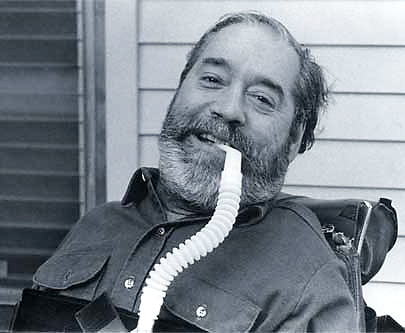Ed Roberts, disability-rights leader and Cal alum, gets his own state day
Disability-rights pioneer Ed Roberts, who was a Cal alum, will be recognized each year on Jan. 23 with a commemorative day on which the state's schools will offer education on disability history, rights, and legal requirements. The California State Legislature unanimously passed the bill, which Gov. Arnold Schwarzenegger signed on July 19.
July 27, 2010

Ed Roberts (Image courtesy of the Ed Roberts Campus.)
January 23 has been named Ed Roberts Day in California, in honor of the Cal alum who pioneered the disability-rights movement on campus and nationwide.
Roberts, who was the first Berkeley student to rely on a wheelchair when he arrived in 1962, is recognized as the father of the independent living movement for people with disabilities and special needs. He died in 1995.
The legislative bill establishing the Ed Roberts Day, to be marked yearly as a day of “special significance” in California’s schools, came about in part because of the behind-the-scenes advocacy efforts of Berkeley senior Alex Ghenis.
Berkeley’s Disabled Students Program placed Ghenis, a geography major, in a paid internship this summer in the Oakland office of California Sen. Loni Hancock, D-Berkeley, who sponsored Senate Bill 1256, which sets aside every Jan. 23 as Ed Roberts Day.
Ghenis, who is the immediate past president of the campus’s Disabled Students Union, worked to gain support for the bill, which passed the Legislature unanimously and was signed by the governor on July 19.
Paul Hippolitus, DSP director, knew Roberts and says that he would have been proud to know that a current Berkeley student was involved in the effort. “Not in memorializing him — he wouldn’t have cared much about that,” says Hippolitus. “But he would have really appreciated the fact that there will be a day dedicated to disability awareness across the school system.”
Roberts had been in a wheelchair since he contracted polio at age 14. When he transferred to Berkeley from the College of San Mateo, he brought with him the 800 pound iron lung he needed for sleeping. But because of it, he met with resistance when he sought campus housing.
At the time, it was legal and common practice in the United States for institutions to refuse admission to people with disabilities, says Hippolitus. “You could say, ‘We can’t accommodate you,’ and there was no recourse,” he recalls. “Ed didn’t accept that.”
The director of Cowell Hospital (then Berkeley’s student health center) offered Roberts a room in an empty wing on the third floor. A dozen severely disabled students followed his lead, moving in as well.
They called themselves “The Rolling Quads,” and Roberts was their leader. They pressured the campus to become more accessible and to fund support services so that they could attend classes while living independently.
“Ed pushed and prodded and argued and convinced people it was wrong” to discriminate against people with disabilities, says Hippolitus. And, he added, Roberts helped disabled people shift their perspective “from being an object of pity and charity — which was forced upon them but they passively accepted — to saying, ‘No, that’s wrong.’ ”
Roberts’ persistence paid off. The Rolling Quads’ advocacy helped launch the Physically Disabled Students Program, the first such student-led campus organization in the country. That program gave rise to Berkeley’s Center for Independent Living, which became a national model for disability advocacy.
Roberts earned a B.A. in 1964 and an M.A. in 1966, both in political science. He also taught in Berkeley’s political science department for six years. Roberts went on to lead the Center for Independent Living. In 1975, Gov. Jerry Brown appointed Roberts director of the Department of Rehabilitation, a position he held until 1983, when he co-founded the World Institute on Disability.
The creation of the commemorative day coincides with the completion of the Ed Roberts Campus, which is slated to open in September at the Ashby BART station in South Berkeley. The center will bring together a broad range of disability-related services and programs in one location.
The campus continues efforts to make older facilities fully accessible to wheelchair riders. For more information about campus accessibility, see the online Campus Access Guide.